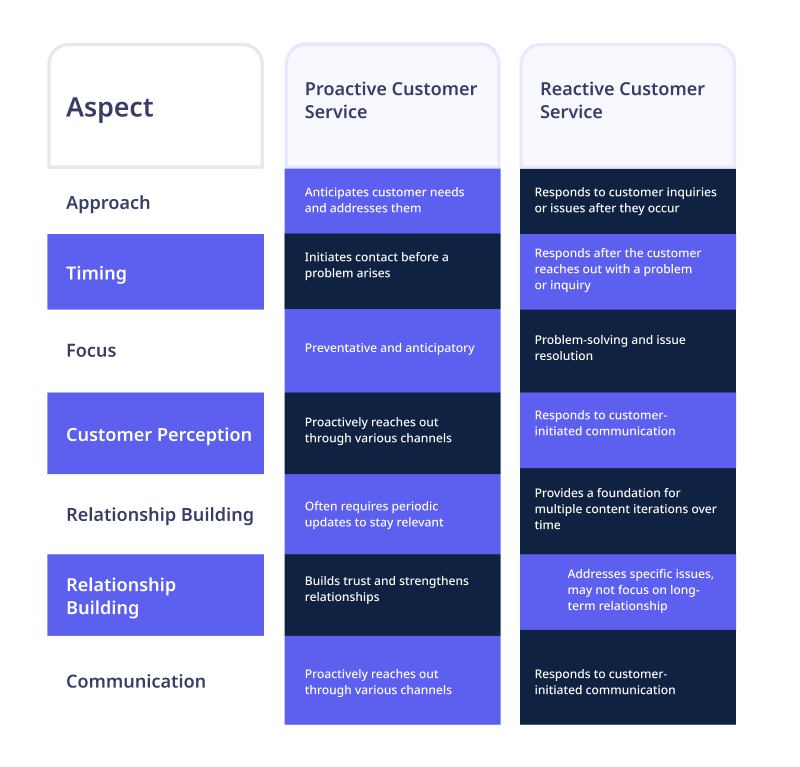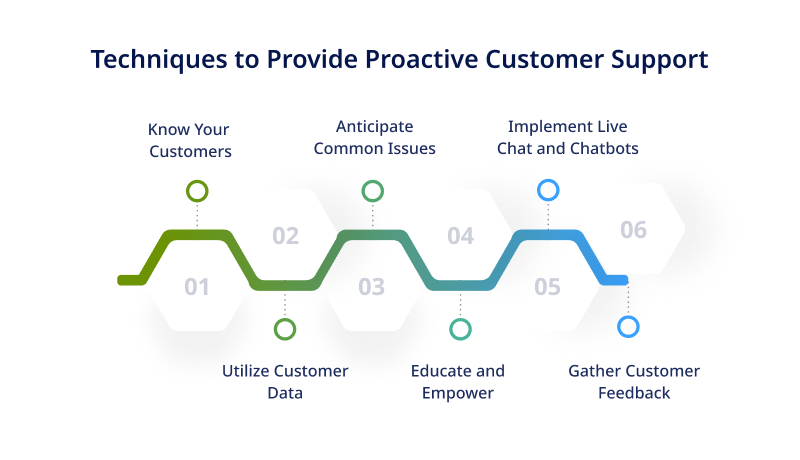With 58% of customers willing to break up a relationship with a firm due to bad customer care, a thorough, proactive customer service strategy is essential to the success of your organization. It is impossible to differentiate yourself from the competition by merely returning client emails or attending the helpline with such high stakes.
According to a recent Gartner study, “proactive customer service results in a full point increase” in important customer success indicators like the Net Promoter, Customer Satisfaction, Customer Effort, and Value Enhancement Score.
Before your clients require assistance, you may increase customer experience and boost customer loyalty by developing a proactive customer service plan.
What is Proactive Customer Support?
Proactive customer support refers to proactive solutions for customer service where firms must foresee and handle potential customers’ wants, queries, and problems. Proactive support is sharing pertinent information, offering assistance, or suggesting solutions in advance rather than only responding to client inquiries or problems. This strategy improves customer satisfaction, fosters trust, and averts possible issues.
To ensure customer pleasure and loyalty, proactive customer care frequently uses techniques including personalized advice, educational content, timely updates, and preventative actions.
Proactive vs. Reactive Customer Service
A company’s strategy in the dynamic world of customer service can greatly impact client happiness and loyalty. Two different strategies for handling client demands are proactive vs. reactive customer service.
Let’s examine the main differences between these strategies.
- Approach
Proactive: Customer care takes the initiative to foresee customer needs and offer assistance before the consumer contacts the company. It emphasizes preventative actions and personalized advice.
Reactive: Reactive approach to customer service answers to questions or concerns brought up by customers. It involves addressing certain issues and offers solutions when asked for.
- Timing
Proactive: Proactive support is offered before a client requests help. It seeks to meet requirements beforehand, frequently through prompt communication and educational content.
Reactive: Reactive support is provided in response to a client’s question or issue. It is addressed once a problem has been brought to the customer support team’s notice.
- Focus
Proactive: It emphasizes problem prevention, making suggestions, and offering resources that enhance the client’s experience.
Reactive: Reactive customer service focuses on addressing particular concerns or questions the client has expressed to address their immediate issue.
- Customer Perception
Proactive: Customers frequently perceive proactive service positively because it shows a proactive approach to meeting their requirements and a dedication to their pleasure.
Reactive: While necessary, reactive service may be seen as simply addressing issues as they arise, which could result in a more neutral or conflicting perception.
- Relationship Building
Proactive: It helps to build deeper relationships by showing a sincere concern for the customer’s welfare and offering value beyond the simple problem-solving process.
Reactive: While providing reactive service is essential for problem-solving, it may not always immediately support efforts to develop relationships.
- Communication
Proactive: To keep consumers informed, educated, and interested, proactive service focuses on prompt and informative communication.
Reactive: Reactive customer service entails immediate response to questions or concerns from the client.
- Problem Avoidance
Proactive: It aims to avoid difficulties by addressing possible pain spots before they affect the client.
Reactive: Reactive service frequently prioritizes fixing current problems above underlying reasons.
How to Provide Proactive Customer Support?
Proactive customer support is a potent tactic enabling organizations to foresee and meet consumer wants before they materialize. Businesses may create a more smooth and gratifying customer experience by adopting a forward-thinking strategy.
Let’s examine the essential techniques for proactive customer service.
- Know Your Customers
The foundation of proactive assistance is having a personal understanding of your consumers. Learn about their tastes, mannerisms, and previous interactions with your company.
You can anticipate their wants thanks to this expertise and provide specialized answers. You show a sincere dedication to your customers’ delight by paying attention to the subtleties of each individual consumer.
- Utilize Customer Data
Leverage the wealth of data to gain valuable insights into customer behavior. Analyze purchase history, browsing patterns, and feedback to identify trends and preferences. Using this data-driven strategy, you can choose product recommendations, limited-time offers, and communication methods.
By harnessing the power of customer data, you can proactively engage with customers in a manner that resonates with their interests.
- Anticipate Common Issues
Using historical data and customer feedback, proactively identify and address common pain points. Develop resources, guides, or FAQs that preemptively solve these issues. You demonstrate foresight and a commitment to customer satisfaction by offering proactive assistance. It saves customers time and effort and reinforces their trust in your brand.
- Educate and Empower
Education is the first step in proactive solutions for customer service. Give your customers the tools they need to get the most out of your goods or services, such as resources, manuals, and knowledge bases.
Customers are more likely to find solutions independently when tutorials, FAQs, and educational information are available, decreasing their dependency on conventional support channels.
- Proactive Communication
Start a conversation with them instead of waiting for your customers to contact you. Based on their interactions with your company, send proactive messages to offer updates, relevant information, or assistance.
For instance, sending a customized email with advice on using a recent purchase demonstrates your dedication to their success.
- Implement Live Chat and Chatbots
Live chat and chatbots are great resources for proactive support. Use chat functionality on your website or application to provide rapid assistance.
Chatbots can be created to respond to frequently asked queries, make product suggestions, or walk users through procedures. These tools guarantee that clients receive assistance exactly when they require it.
- Gather Customer Feedback
It’s proactive to respond to client feedback to enhance your goods and services. Utilise surveys, reviews, or direct conversations to gather feedback. Use this information to identify areas that need to be improved and take action before issues become serious.
You show a dedication to customer satisfaction and ongoing improvement by actively seeking and acting upon feedback.
5 Examples of Proactive Customer Service
Proactive customer service is an example of exceptional care that goes beyond mere issue resolution. It anticipates and fulfills customer needs before they even arise.
Here are five examples of businesses that have mastered the art of proactive customer service, setting a benchmark for industry excellence.
- Amazon’s Anticipatory Shipping
Based on a customer’s browsing and purchase history, Amazon uses sophisticated algorithms to forecast what the consumer will order. So that they can be delivered even more quickly when an order is placed, they pre-ship these items to a nearby distribution facility.
- Netflix’s Content Recommendations
Netflix employs machine learning algorithms to analyze user viewing patterns and make personalized movie and TV program recommendations. By assisting viewers in finding information they are likely to love, this proactive strategy improves the user experience.
- Apple’s iOS Updates Notifications
Apple users are proactively informed about available iOS updates. By doing this, consumers are kept up to date on new functions and enhancements and their devices are guaranteed to have the most recent security patches installed.
- Spotify’s Discover Weekly Playlist
Users can create custom playlists on Spotify based on their listening habits and preferences. Every week, users get a fresh playlist with tracks they haven’t heard. This function introduces users to new artists and genres.
- Delta Airlines’ Weather Waivers
Delta keeps a close eye on the weather because it could affect flights. When dangerous weather is expected, Delta frequently offers waivers that let customers change their flights without being charged. This proactive measure assists travellers in avoiding flight delays and exemplifies Delta’s dedication to client satisfaction.
The Bottom Line
In customer service, proactive approaches stand as the beacon of exceptional care. Beyond problem-solving, they anticipate needs, provide tailored solutions, and foster enduring satisfaction.
By implementing these strategies, businesses can forge deeper connections, build trust, and ultimately create a customer experience that transcends expectations.
Embracing proactive customer service is not just a strategy; it’s a commitment to putting customers at the heart of every interaction. With these approaches, businesses can elevate customer satisfaction to new heights.







